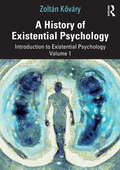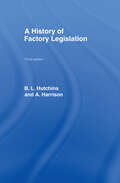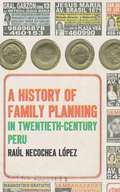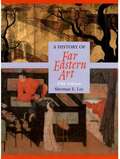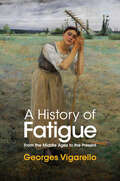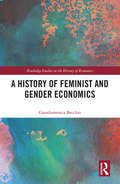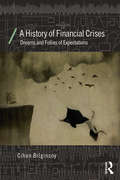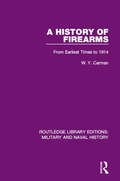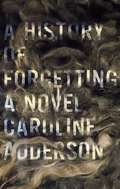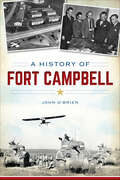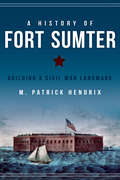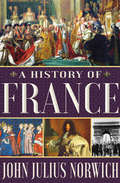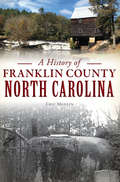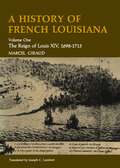- Table View
- List View
A History of Existential Psychology: Introduction to Existential Psychology Volume 1
by Zoltán KőváryThe first in a two-part set, this book takes a deep dive into the history and theory of existential psychology.Beginning with a discussion of the “existentialism and psychology problem,” the book presents the philosophical and historical roots of existential psychology. It introduces the most important philosophical schools in the development of existentialism and their creators, such as Kierkegaard, Nietzsche, Heidegger and Sartre, as well as the literary roots of existentialism in the writings of Dostoevsky and Kafka and the important contribution of psychoanalysis and phenomenological psychiatry. The book then goes on to look at the existential psychology schools, including daseinsanalysis, logotherapy and existential analysis, the existential-humanistic school and the existential-phenomenological school.Going beyond the questions of therapy and counseling that typically make up the study of existential psychology, the book offers the ultimate introduction for students and scholars of this fascinating and deeply rooted discipline. It may also interest professionals working in related fields.
A History of Factory Legislation
by Amy Harrison B. Leigh HutchinsFirst Published in 1966. Routledge is an imprint of Taylor & Francis, an informa company.
A History of Fake Things on the Internet
by Walter ScheirerA Next Big Idea Club "Must Read" for December 2023 As all aspects of our social and informational lives increasingly migrate online, the line between what is "real" and what is digitally fabricated grows ever thinner—and that fake content has undeniable real-world consequences. A History of Fake Things on the Internet takes the long view of how advances in technology brought us to the point where faked texts, images, and video content are nearly indistinguishable from what is authentic or true. Computer scientist Walter J. Scheirer takes a deep dive into the origins of fake news, conspiracy theories, reports of the paranormal, and other deviations from reality that have become part of mainstream culture, from image manipulation in the nineteenth-century darkroom to the literary stylings of large language models like ChatGPT. Scheirer investigates the origins of Internet fakes, from early hoaxes that traversed the globe via Bulletin Board Systems (BBSs), USENET, and a new messaging technology called email, to today's hyperrealistic, AI-generated Deepfakes. An expert in machine learning and recognition, Scheirer breaks down the technical advances that made new developments in digital deception possible, and shares behind-the-screens details of early Internet-era pranks that have become touchstones of hacker lore. His story introduces us to the visionaries and mischief-makers who first deployed digital fakery and continue to influence how digital manipulation works—and doesn't—today: computer hackers, digital artists, media forensics specialists, and AI researchers. Ultimately, Scheirer argues that problems associated with fake content are not intrinsic properties of the content itself, but rather stem from human behavior, demonstrating our capacity for both creativity and destruction.
A History of False Hope: Investigative Commissions in Palestine
by Lori AllenThis book offers a provocative retelling of Palestinian political history through an examination of the international commissions that have investigated political violence and human rights violations. More than twenty commissions have been convened over the last century, yet no significant change has resulted from these inquiries. The findings of the very first, the 1919 King-Crane Commission, were suppressed. The Mitchell Committee, convened in the heat of the Second Intifada, urged Palestinians to listen more sympathetically to the feelings of their occupiers. And factfinders returning from a shell-shocked Gaza Strip in 2008 registered their horror at the scale of the destruction, but Gazans have continued to live under a crippling blockade. Drawing on debates in the press, previously unexamined UN reports, historical archives, and ethnographic research, Lori Allen explores six key investigative commissions over the last century. She highlights how Palestinians' persistent demands for independence have been routinely translated into the numb language of reports and resolutions. These commissions, Allen argues, operating as technologies of liberal global governance, yield no justice—only the oppressive status quo. A History of False Hope issues a biting critique of the captivating allure and cold impotence of international law.
A History of Family Planning in Twentieth-Century Peru
by Raúl Necochea LópezAdding to the burgeoning study of medicine and science in Latin America, this important book offers a comprehensive historical perspective on the highly contentious issues of sexual and reproductive health in an important Andean nation. Raul Necochea Lopez approaches family planning as a historical phenomenon layered with medical, social, economic, and moral implications. At stake in this complex mix were new notions of individual autonomy, the future of gender relations, and national prosperity.The implementation of Peru's first family planning programs led to a rapid professionalization of fertility control. Complicating the evolution of associated medical services were the conflicting agendas of ordinary citizens, power brokers from governmental and military sectors, clergy, and international health groups. While family planning promised a greater degree of control over individuals' intimate lives, as well as opportunities for economic improvement through the effective management of birth rates, the success of attempts to regulate fertility was far from assured. Today, Necochea Lopez observes, although the quality of family planning resources in Peru has improved, services remain far from equitably available.
A History of Far Eastern Art
by Sherman E. Lee Naomi Noble RichardCovers Himalayan areas--Ladakh, Kashmir, Tibet, and Nepal. New chronologies in Stone age and Bronze Age, China, Korea, and Japan.
A History of Fascism, 1914-1945
by Stanley G. PayneFocusing mostly on Italy and Germany but also considering Spain, Romania, Japan, and movements in other countries, Payne (history, University of Wisconsin) describes fascism as revolutionary ultranationalism based on national rebirth, extreme elitism, mass mobilization, and the promotion of violence and military virtues. He also suggests that the early Russian communists borrowed many techniques from fascism, and that though we are fairly well-inoculated against fascism itself, the values it represents could still emerge in new forms.
A History of Fatigue: From the Middle Ages to the Present
by Georges Vigarello&“Stress,&” &“burn out,&” &“mental overload&”: the twentieth and twenty-first centuries have witnessed an unrelenting expansion of the meaning of fatigue. The tentacles of exhaustion insinuated themselves into every aspect of our lives, from the workplace to the home, from our relationships with friends and family to the most intimate aspects of our lives. All around us are the signs of a &“burn-out society,&” a society in which fatigue has become the norm. How did this happen? This pioneering book explores the rich and little-known history of fatigue from the Middle Ages to the present. Vigarello shows that our understanding of fatigue, the words used to describe it, and the symptoms and explanations of it have varied greatly over time, reflecting changing social mores and broader aspects of social and political life. He argues that the increased autonomy of people in Western societies (whether genuine or assumed), the positing of a more individualized self, and the ever expanding ideal of independence and freedom have constantly made it more difficult for us to withstand anything that constrains or limits us. This painful contradiction causes weariness as well as dissatisfaction. Fatigue spreads and becomes stronger, imperceptibly permeating everything, seeping into ordinary moments and unexpected places. Ranging from the history of war, religion and work to the history of the body, the senses and intimacy, this history of fatigue shows how something that seems permanently centered in our bodies has, over the course of centuries, also been ingrained in our minds, in the end affecting the innermost aspects of the self.
A History of Feminist and Gender Economics (Routledge Studies in the History of Economics)
by Giandomenica BecchioThis book offers a historical exploration of the genesis of feminist economics and gender economics, as well as their theoretical and methodological differences. Its narrative also serves to embed both within a broader cultural context. Although both feminist economics and gender neoclassical economics belong to the cultural process related to the central role of the political economy in promoting women’s emancipation and empowerment, they differ in many aspects. Feminist economics, mainly influenced by women’s studies and feminism, rejected neoclassical economics, while gender neoclassical economics, mainly influenced by home economics and the new home economics, adopted the neoclassical economics’ approach to gender issues. The book includes diverse case studies, which also highlight the continuity between the story of women’s emancipation and the more recent developments of feminist and gender studies. This volume will be of great interest to researchers and academia in the fields of feminist economics, gender studies, and the history of economic thought.
A History of Film Music
by Mervyn CookeThis book provides a comprehensive and lively introduction to the major trends in film scoring from the silent era to the present day, focussing not only on dominant Hollywood practices but also offering an international perspective by including case studies of the national cinemas of the UK, France, India, Italy, Japan and the early Soviet Union. The book balances wide-ranging overviews of film genres, modes of production and critical reception with detailed non-technical descriptions of the interaction between image track and soundtrack in representative individual films. In addition to the central focus on narrative cinema, separate sections are also devoted to music in documentary and animated films, film musicals and the uses of popular and classical music in the cinema. The author analyses the varying technological and aesthetic issues that have shaped the history of film music, and concludes with an account of the modern film composer's working practices.
A History of Financial Crises: Dreams and Follies of Expectations (Economics as Social Theory)
by Cihan Bilginsoy"Once-in-a-lifetime" financial crises have been a recurrent part of life in the last three decades. It is no longer possible to dismiss or ignore them as aberrations in an otherwise well-functioning system. Nor are they peculiar to recent times. Going back in history, asset price bubbles and bank-runs have been an endemic feature of the capitalist system over the last four centuries. The historical record offers a treasure trove of experience that may shed light on how and why financial crises happen and what can be done to avoid them - provided we are willing to learn from history. This book interweaves historical accounts with competing economic crisis theories and reveals why commentaries are often contradictory. First, it presents a series of episodes from tulip mania in the 17th century to the subprime mortgage meltdown. In order to tease out their commonalities and differences, it describes political, economic, and social backgrounds, identifies the primary actors and institutions, and explores the mechanisms behind the asset price bubbles, crashes, and bank-runs. Second, it starts with basic economic concepts and builds five competing theoretical approaches to understanding financial crises. Competing theoretical standpoints offer different interpretations of the same event, and draw dissimilar policy implications. This book analyses divergent interpretations of the historical record in relation to how markets function, the significance of market imperfections, economic decision-making process, the role of the government, and evolutionary dynamics of the capitalist system. Its diverse theoretical and historical content of this book complements economics, history and political science curriculum.
A History of Finnish Higher Education from the Middle Ages to the 21st Century (Higher Education Dynamics #52)
by Jussi VälimaaThis book unravels the origins, continuities, and discontinuities of Finnish higher education as part of European higher education from the Middle Ages to the 21st century. It describes the emergence of universities in the Middle Ages and the Finnish student, and moves on to the Reformation and the end of Swedish rule. It then discusses the founding of the Royal Academy of Turku, its professors and governing bodies, its role as a community, student numbers, the research and controversies. Travelling through the age of autonomy, the first decades of independence and the Second World War, the book examines the expansion of higher education, the development of the system, and the establishment of polytechnics. It concludes by analysing the multiple institutional and organisational layers of Finnish higher education. Altogether, the book offers an historical study that shows how and why education and higher education have been important in the process of making the Finnish nation and nation state.
A History of Firearms: From Earliest Times to 1914 (Routledge Library Editions: Military and Naval History #7)
by W. Y. CarmanAmply illustrated with pen & ink drawings, and including a glossary of key terms, this volume, originally published in 1955, traces the history of firearms and the pioneers who made that history, step by step, to the fringe of a complex modern science.
A History of Fishing in the Florida Keys: Angler's Paradise (Sports)
by Bob T. EpsteinSince the arrival of Ponce de Leon in the 1500s, the Florida Keys have evolved from a dense, nearly impenetrable jungle full of bears, pumas, snakes, alligators and crocodiles into America's Caribbean islands. And the fish in the region have made the Keys one of the nation's favorite playgrounds for anglers. The Keys are home to more saltwater fishing records than any other angling destination in the world and offer sportsmen an array of amazing fish, from tarpon and Spanish mackerel to mahi-mahi and bonefish. U.S. presidents, celebrities and the world's greatest fishermen and women have cruised the waters of South Florida. Join author Bob T. Epstein on a journey through the storied history of fishing in the Florida Keys.
A History of Florida through New World Maps: Borders of Paradise (Florida and the Caribbean Open Books Series)
by Dana Ste. ClaireThe books in the Florida and the Caribbean Open Books Series demonstrate the University Press of Florida’s long history of publishing Latin American and Caribbean studies titles that connect in and through Florida, highlighting the connections between the Sunshine State and its neighboring islands. Books in this series show how early explorers found and settled Florida and the Caribbean. They tell the tales of early pioneers, both foreign and domestic. They examine topics critical to the area such as travel, migration, economic opportunity, and tourism. They look at the growth of Florida and the Caribbean and the attendant pressures on the environment, culture, urban development, and the movement of peoples, both forced and voluntary.The Florida and the Caribbean Open Books Series gathers the rich data available in these architectural, archaeological, cultural, and historical works, as well as the travelogues and naturalists’ sketches of the area prior to the twentieth century, making it accessible for scholars and the general public alike.The Florida and the Caribbean Open Books Series is made possible through a grant from the National Endowment for the Humanities and the Andrew W. Mellon Foundation, under the Humanities Open Books program.
A History of Folding in Mathematics: Mathematizing The Margins (Science Networks. Historical Studies #59)
by Michael FriedmanWhile it is well known that the Delian problems are impossible to solve with a straightedge and compass – for example, it is impossible to construct a segment whose length is the cube root of 2 with these instruments – the discovery of the Italian mathematician Margherita Beloch Piazzolla in 1934 that one can in fact construct a segment of length the cube root of 2 with a single paper fold was completely ignored (till the end of the 1980s). This comes as no surprise, since with few exceptions paper folding was seldom considered as a mathematical practice, let alone as a mathematical procedure of inference or proof that could prompt novel mathematical discoveries. A few questions immediately arise: Why did paper folding become a non-instrument? What caused the marginalisation of this technique? And how was the mathematical knowledge, which was nevertheless transmitted and prompted by paper folding, later treated and conceptualised? Aiming to answer these questions, this volume provides, for the first time, an extensive historical study on the history of folding in mathematics, spanning from the 16th century to the 20th century, and offers a general study on the ways mathematical knowledge is marginalised, disappears, is ignored or becomes obsolete. In doing so, it makes a valuable contribution to the field of history and philosophy of science, particularly the history and philosophy of mathematics and is highly recommended for anyone interested in these topics.
A History of Food in 100 Recipes
by William SitwellA riveting narrative history of food as seen through 100 recipes, from ancient Egyptian bread to modernist cuisine.We all love to eat, and most people have a favorite ingredient or dish. But how many of us know where our much-loved recipes come from, who invented them, and how they were originally cooked? In A HISTORY OF FOOD IN 100 RECIPES, culinary expert and BBC television personality William Sitwell explores the fascinating history of cuisine from the first cookbook to the first cupcake, from the invention of the sandwich to the rise of food television. A book you can read straight through and also use in the kitchen, A HISTORY OF FOOD IN 100 RECIPES is a perfect gift for any food lover who has ever wondered about the origins of the methods and recipes we now take for granted.
A History of Forgetting
by Caroline AddersonMalcolm, an aging hairdresser, is reclusive and bitter. Alison, a salon apprentice, is dismissed by Malcolm for her embarrassing innocence. When their colleague is murdered by neo-Nazis, however, the two embark on an unplanned pilgrimage to Auschwitz. A moving and sharp-edged novel by the award-winning author of Ellen in Pieces.
A History of Fort Campbell (Military)
by John O'BrienThe mission at Fort Campbell has changed over the past seventy-five years, and the city has grown and adapted to meet new challenges. It was conceived before Pearl Harbor as the Tennessee-Kentucky Armor Camp and has progressed in recent years to meet changing national security needs and the transformation of the U.S. Army. The fort is home to the army's most elite air assault and airborne units. It is also the largest employer in Tennessee and Kentucky and puts $2.6 billion into the local economy each year. Author and post historian John O'Brien details the historic ride that took Fort Campbell from a "Giant Bachelor City" to a "World-Class Army Home."
A History of Fort Sumter: Building a Civil War Landmark (Landmarks Ser.)
by M. Patrick HendrixA thrilling account—from construction to ruin—of the South Carolina fort where the Civil War&’s opening shots were fired, forging its place in history. In 1829, construction began on a fort atop a rock formation in the mouth of Charleston Harbor. Decades later, Fort Sumter was near completion on December 26, 1860, when Maj. Robert Anderson occupied it in response to the growing hostilities between the North and South. As a symbol of sedition for the North and holy ground for the South, possession of Fort Sumter was deemed essential to both sides when the Civil War began. By 1864, the fort, heavily bombarded by Union artillery, was a shapeless mass of ruins, mostly burned rubble and sand with a garrison of Confederate soldiers holding its ground. Join author M. Patrick Hendrix as he follows the tumultuous lives of the men who fought to control what later became one of the most revered monuments to the war. Includes photos
A History of France
by John Julius NorwichAn &“engaging, enthusiastic, sympathetic, funny&” journey through French history from the New York Times-bestselling author of Absolute Monarchs (The Wall Street Journal). Beginning with Julius Caesar&’s conquest of Gaul in the first century BC, this study of French history comprises a cast of legendary characters―Charlemagne, Louis XIV, Napoleon, Joan of Arc, and Marie Antoinette, to name a few―as John Julius Norwich chronicles France&’s often violent, always fascinating history. From the French Revolution―after which neither France nor the world would be the same again―to the storming of the Bastille, from the Vichy regime and the Resistance to the end of the Second World War, A History of France is packed with heroes and villains, battles and rebellion—written with both an expert command of detail and a lively appreciation for the subject matter by this &“true master of narrative history&” (Simon Sebag Montefiore).
A History of Franklin County, North Carolina (Brief History)
by Eric MedlinThe story of Franklin County is one of remarkable change and growth over the past 250 years. From its Native American roots, this corner of the eastern Piedmont has become a center for tobacco plantations, textile mills and cotton cultivation. It has seen seminal moments in the history of public education, Methodism and even capital punishment. One governor called Louisburg home, while several more have visited and even presidents have made brief stops. Local historian Eric Medlin narrates the history of one of the most exceptional parts of the great state of North Carolina.
A History of French Louisiana: The Company of the Indies, 1723–1731
by Marcel GiraudThe first four volumes of Marcel Giraud's History of French Louisiana, published in France between 1951 and 1974, represent the most exhaustive and authoritative scholarly study of France's establishment in the lower Mississippi Valley. In this fifth and final volume of Giraud's magnum opus, published in the United States for the first time ain a translation by Brian Pearce, Giraud unravels the complex story of the Company of the Indies between 1723 and 1731 and traces the development of the Louisiana colony during those difficult years.When the Company of the Indies was reorganized after the defection of Scotsman John Law, its leaders faced economic and political conflicts in both France and America. Managerial abuses and power struggles within the new system often interfered with the administrative process and created divisions of loyalties among officials and settlers.Political leaders were not, however, the only ones struggling for control within the new territory. As Giraud relates, Jesuit and capuchin religious leaders were also at odds with one another over the division of territory in which they were to minister. Giraud explores the strained relationship between the two orders and the political motives an associations that influenced their leaders. Despite political and religious turmoil within the territory, the foundations of colonial society were being laid in New Orleans and Mobile. Attributing the growth of these areas to agricultural expansion and to the introduction of slavery, Giraud offers a lively, detailed description of the economic and social development of Louisiana's nascent urban centers.Giraud also traces the expansion of colonial control into the interior of the colony -- the Illinois country, Nachitoches, and the Natchez country. It was the neglect of the defense of these outposts, blamed by Giraud of the Company's emphasis on economic development and its strict fund-sharing policy, that ultimately resulted in its downfall. On November 28, 1729, angry Indians attacked the small French garrison in Natchez, massacring numerous soldiers and civilians. This attack marked the beginning of war with the Natchez tribe and the withdrawal of the Company of the Indies from Louisiana.
A History of French Louisiana: The Reign of Louis XIV, 1698--1715
by Marcel Giraud Joseph C. LambertThe death of Louis XIV in 1715 and the accession of his more progressive younger brother as Regent of France might have brought some hopeful changes to Louisiana, France's tiny, struggling outpost on the Gulf of Mexico. However, the continuation of the debilitating regime of the merchant Antoine Crozat and the extreme impoverishment of the French Treasury Following the disastrous wars of Louis XIV meant that no radical changes were possible. Instead, these few years at the beginning of the Regency represented a period of transition for the colony, when the need for a new administrative regime for Louisiana was met in France by a growing awareness of the strategic and economic potential of the Mississippi settlements. All of these conditions prepared the way for the appearance on the scene of the Company of the West in 1717.In his detailed survey of this brief but crucial period of Louisiana's history, Marcel Giraud assesses the new mood and conditions in France -- the personnel and objectives of the Council of the Navy, which oversaw the colony's administration; the advances in scientific opinion and their impact on Louisiana; and the political, fiscal, and economic conditions that created a new appreciation of the colony of official circles -- while describing actual conditions in the colony. Giraud portrays the Louisiana of 1715 as a few clusters of squalid buildings scattered along the Gulf Coast from Alabama to Natchitoches, inhabited by largely dispirited settlers and soldiers who for the most part lacked the barest necessities of life.Crozat's essentially self-serving regime made this a period of virtual stagnation. Rivalries among the colony's administrative personnel, especially between the governors and the Le Moyne family and their supporters, impeded development, as did the inadequacy of the priests sent to minister to the colony; the paucity of women, farmers, and skilled workers; and the infertile soil around the sties chosen for the forts and settlements.Relations with the indigenous populations were hindered by the lack of acceptable trade goods, as were efforts by the French colonists to establish commercial relations with the neighboring Spanish colonies. At the same time, Louisiana bore the encroachments of better-supplied British traders who were moving into Alabama and the Illinois country and developing regular trade with Indian tribes whom the French claimed as their own clients. With his customary thoroughness and scrupulous attention to documentary details, Marcel Giraud provides a vivid description of a struggling colony hovering between extinction and the spark of growth that would, in years to come, establish it as a viable French outpost in North America. Despite the obstacles facing Louisiana during these difficult years of transition, the colony survived to experience new expansion and development under the Company of the West.
A History of French Louisiana: The Reign of Louis XIV, 1698–1715
by Marcel GiraudMarcel Giraud has long been acknowledged as the leading European scholar in the filed of the history and development of colonial French Louisiana. Now the long-awaited English translation of Volume One of his Histoire de la Louisiana Française makes the results of his meticulous research readily available. Professor Giraud explores all phases of the beginnings of colonization in the vast Louisiana territory from the first voyage of d'Iberville to the end of the reign of Louis XIV. He examines the attitude of he French regency, the interest of the Church, and the effects of wars and private monopoly on the struggling settlements along the coast of the Gulf of Mexico and on the Mississippi. The almost unbelievable poverty with which the emigrants contended, brought on the their lack of agricultural knowledge and by France's niggardly financial support, is portrayed vividly.Professor Giraud has assembled an immense store of information bolstered by documentation from all available sources. The book includes an excellent bibliography and a list of archival resources.
